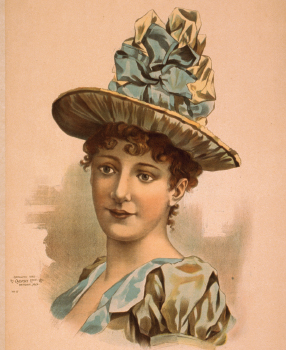

Catherine Ferguson opens New York City’s first Sunday school. Born a slave, with her mother sold when she was eight, Ferguson is sensitive to the needs of destitute children. The Murray Street Sabbath School, integrated from its founding, serves poor children for forty years.
School graduations offer one of the few opportunities young women at this time have to speak in public.

Amelia Simmons publishes the first American cookbook.

Elizabeth Ann Bayley Seton is part of a group that founds the Society for the Relief of Poor Widows with Small Children; she serves as its treasurer until 1804. After converting to Catholicism in 1805, Seton founds the Sisters of Charity of St. Joseph, the first American sisterhood, in 1809 in Maryland. The funds from the boarders at St. Joseph’s School enable her to offer free schooling to needy girls, thus leading to her being called the “foundress of the parochial school system in the United States.” She is canonized as a Roman Catholic saint in 1975.
The United States has the highest recorded birthrate in the world at 7.04 babies per woman.

While accompanying her husband, Sacagawea serves as a guide and interpreter for the Lewis and Clark expedition, whose mission is to find a water route through North America and explore the uncharted West. During this journey of over two years, the Shoshone woman takes on an increasingly important role because since she and her baby accompany the group, hostile Indian tribes recognize that the expedition is peaceful. It is believed that more mountains, lakes, and streams bear her name than that of any other North American woman.

Catherine Greene gives Eli Whitney the idea of a brush to sweep away cotton seeds; he gets full credit for the invention of the cotton gin.

Mary Kies receives the first patent awarded to a woman. The device she invented was for weaving straw with silk or thread.

Mary Young Pickersgill makes the flag that serves as the inspiration for Francis Scott Key’s “The Star Spangled Banner.”

First Lady Dolley Madison flees a burning White House but manages to save many historic paintings. She is a hostess extraordinaire during the administration of her husband, President James Madison, just as she was when he was Thomas Jefferson’s secretary of state and as she would be for many years thereafter.

Factory workers in the United States number one hundred thousand. Two-thirds of them are women and children, who are paid significantly less than men.

After her husband’s death, Kaahumanu becomes co-ruler of Hawaii with the new king, Kamehameha II. She is an active proponent of fair law and uses her power to abolish many restrictions on women. She encourages the new king to eat publicly with women, a previously forbidden act. In 1824, she proclaims Hawaii’s first code of laws that prohibit murder, theft, and fighting. She orders that schools be created for all people to learn to read and write, and she establishes trial by jury.

Of 871,000 black women in the United States, 86 percent are slaves.